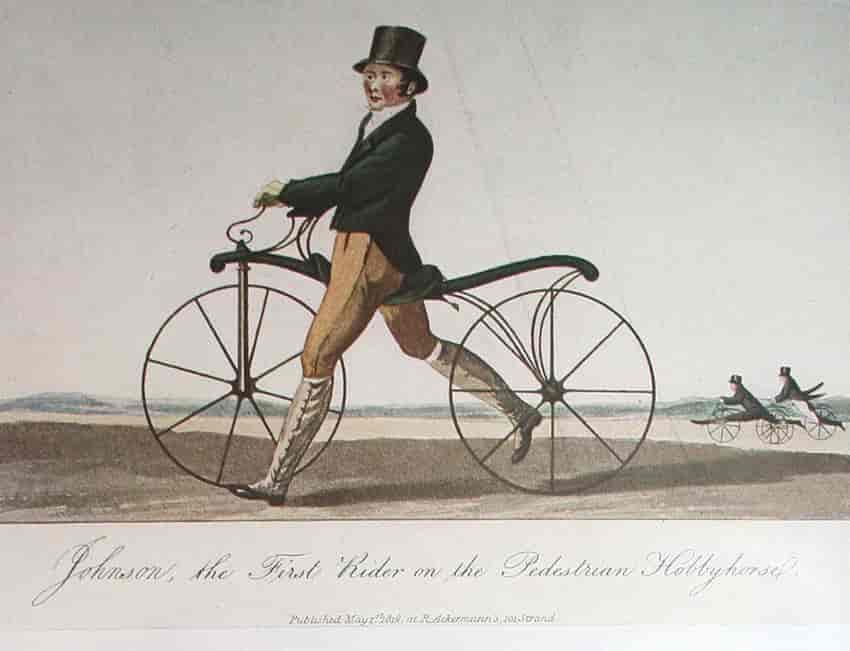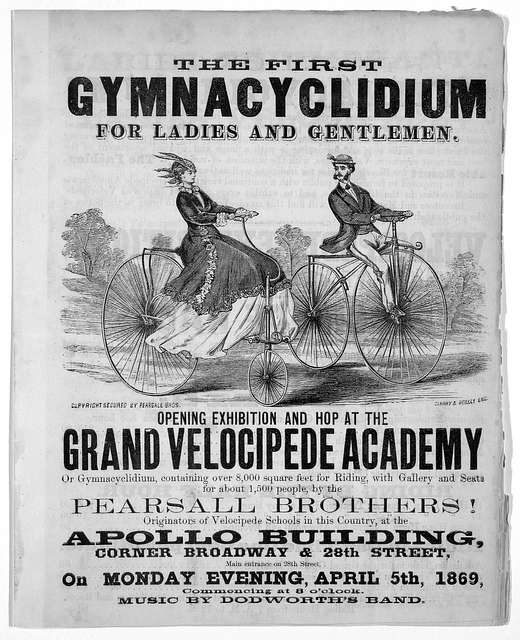Today the cyclist is infra-dig unless one is dressed in lycra and riding a high-end cycle that costs more than a car and the reason for cycling is recreation or sport. The cycle as a mode of commute, then, is for the poor, for those who have no other option and such cyclists are not considered as having a right to the road. Yet this humble vehicle – a simple construct of two wheels, a chain, some cranks, pedals, and metal rods - was once considered to be the pinnacle of transportation.
In the 18th century, horse carriages ruled the road but the cost of maintaining the carriage and more importantly horses was high. Speed too was limited by, well, horsepower. There was a great deal of interest in developing a transport which was powered by some mechanical means and therefore would be less expensive, messy, and more accessible. After much experimentation, in 1817, a German, Karl von Drais, invented the draisine or hobby horse or dandy horse which really was a cycle that required the cyclist to keep pushing the ground with the feet - sort of like a Segway but a cycle-shaped one. Of course on a slope, one could cruise down but brakes were not known in the early days so the results could be disastrous. But clearly it had its limitations.

The dandy horse or hobby horse | SNL
It took till the 1860s for the true precursor to a cycle to develop in Paris. This was called a velocipede (French for swift foot) but had pedals which were directly connected to the front wheel so the cyclist in essence sat above the front wheel and that was the driving wheel of the vehicle. Various versions came about including the famous high wheeler or penny farthing where one wheel was much larger than the other one. At the same time, strong competition between manufacturers to overcome the technical issues with the high wheeler and to increase the speed of the cycle, led to jumps in design including the introduction of the chain drive and making the two wheels of equal size. These came to be known as safety bicycles.

A penny farthing velocipede | FreeSVG
A global footprint
Through the 1870s, velocipedes became quite popular in Europe and America and even in India. Apparently in 1869- 70 a Phantom (a brand) velocipede was imported by an Englishman in Madras and then in 1872, a 46 inch (referring to wheel diameter) Ariel velocipede was also sent to India. In spite of the popularity of the velocipede, costs were still high and so they were associated with young, well-heeled and indolent young men. Hard core velocipede enthusiasts were out to convert others. Velocipede companies sponsored races, set up arenas for people to hire and learn to cycle. Some even had circus-like exhibitions where riders showed off their velocipede skills.

An advertisement for a cycling school | Picryl
While bicycles came late to India, they quickly caught on among the British elite, who formed cycling clubs and took to exploring by cycle, and then to Indians as well. Within 30-odd years, i.e by 1908, there were 3000+ cycles in Madras city alone. All of these of course were imported largely from England. The two World Wars impacted the inflow of cycles but the demand grew after the war years. The big names, which are still known in India, were Hercules, BSA, Raleigh, and Rudge-Whitworth. It was only from the 1940s onwards that the assembly of cycles in India began with Raleigh collaborating with a local entrepreneur. Repair and of course a burgeoning second-hand market existed. The swadeshi movement gave further impetus to the development of a homegrown manufacturing space.
The late 19th and early 20th century was the heyday of the cycle. It was seen as a miracle of modern engineering, a sign of progress, and a convenient and healthy mode of commute for the masses. But with the advent of the motor vehicle in the 1920s, the charm of the cycle waned, especially in countries like India where it was also linked to perceptions of caste and class superiority.
Influencing shifts in couture and technology
But the early cycle had its moments. The cycling craze drove changes in Victorian attire, road surfaces, and led to the invention of the pneumatic tire. In the 19th century, women were covered up from head to toe in Europe and had a number of rather restrictive layers of clothing on. Cycling with these was impossible. Some bold women led the push to change attitudes by wearing modified trousers that came to be called bloomers.
The velocipede clubs that popped up all over Europe and America loved long rides across the country and this led to a push for better roads i.e. macadamized roads. They also lobbied for the cycle to be recognized as having a right to the roads as well as the right to ride on park paths. These groups were also instrumental in having good maps published and roadside facilities for the cyclist who liked to do long distance trips across the countryside.
And finally sometime in the late 19th century, a Scottish veterinarian named Dunlop invented the rubber tyre to improve the suspension and comfort of riding a cycle (till then, wheels were just rims of wood or metal). Slowly, the cost of a cycle finally came down and became affordable for the general public. The armed forces and the police, including in India, began to use the cycle. In some cities, banks and courier services began to employ young boys on bicycles to carry messages and packages. Finally the dream of an affordable, clean, and comfortable (mechanical) horse had been achieved.
Cycles have also made their mark in the motorcycle industry and in aviation. The motorcycle was invented by a former bicycle mechanic, Glenn Curtiss. The Wright brothers too were bicycle mechanics who used those skills to develop their aeroplanes. They even used their bicycles to understand the principles of flight - attaching a miniature wing and drag plate to the bicycle which was then raced through a wind tunnel and measurements taken on lift and drag.
The cycle comes a full circle
Cycles were hailed in the early years but lost ground to the motor vehicle. The perspective of the cycle as being for the well-heeled has come full circle with the rise of cycling as a recreation/sporting activity today. But the ideal of the cycle as a transportation means for the masses took time to achieve and with the advent of the motor vehicle, it has lost ground again. Although cycling is also slowly being recognised as the answer to pollution, traffic congestion, road safety, and of course equity on the road, there is much to be done if the cycle’s image as a transportation choice is to be burnished.
For the history buffs, more information on the cycle can be found in these books: Bicycle – The History by David A. Herlihy and Everyday Technology: Machines and the Making of India’s Modernity by David Arnold.
Add new comment